The Role of Balanced Scorecard in Improving Organizational Performance
VerifiedAdded on 2019/09/30
|10
|2301
|364
Report
AI Summary
This report provides a comprehensive analysis of the Balanced Scorecard (BSC) as a strategic management tool designed to improve organizational performance. It begins with an introduction to the BSC, developed by Kaplan and Norton, and its evolution from traditional management approaches. The report details the four perspectives of the BSC: financial, customer, internal business processes, and learning and growth, and how they contribute to a holistic view of an organization. It explains how the BSC helps organizations translate their strategies into actionable terms and align the entire organization toward achieving strategic goals. The report discusses the use of both financial and non-financial measures, emphasizing the importance of a balanced approach. It also highlights the BSC's role in employee compensation and its impact on employee motivation. Furthermore, the report includes a case study of Infosys, demonstrating how the BSC can be effectively implemented to achieve significant organizational growth and strategic transformation. The report concludes by summarizing the benefits of the BSC and its continued relevance in modern business environments.

balance Scorecard
Paraphrase This Document
Need a fresh take? Get an instant paraphrase of this document with our AI Paraphraser
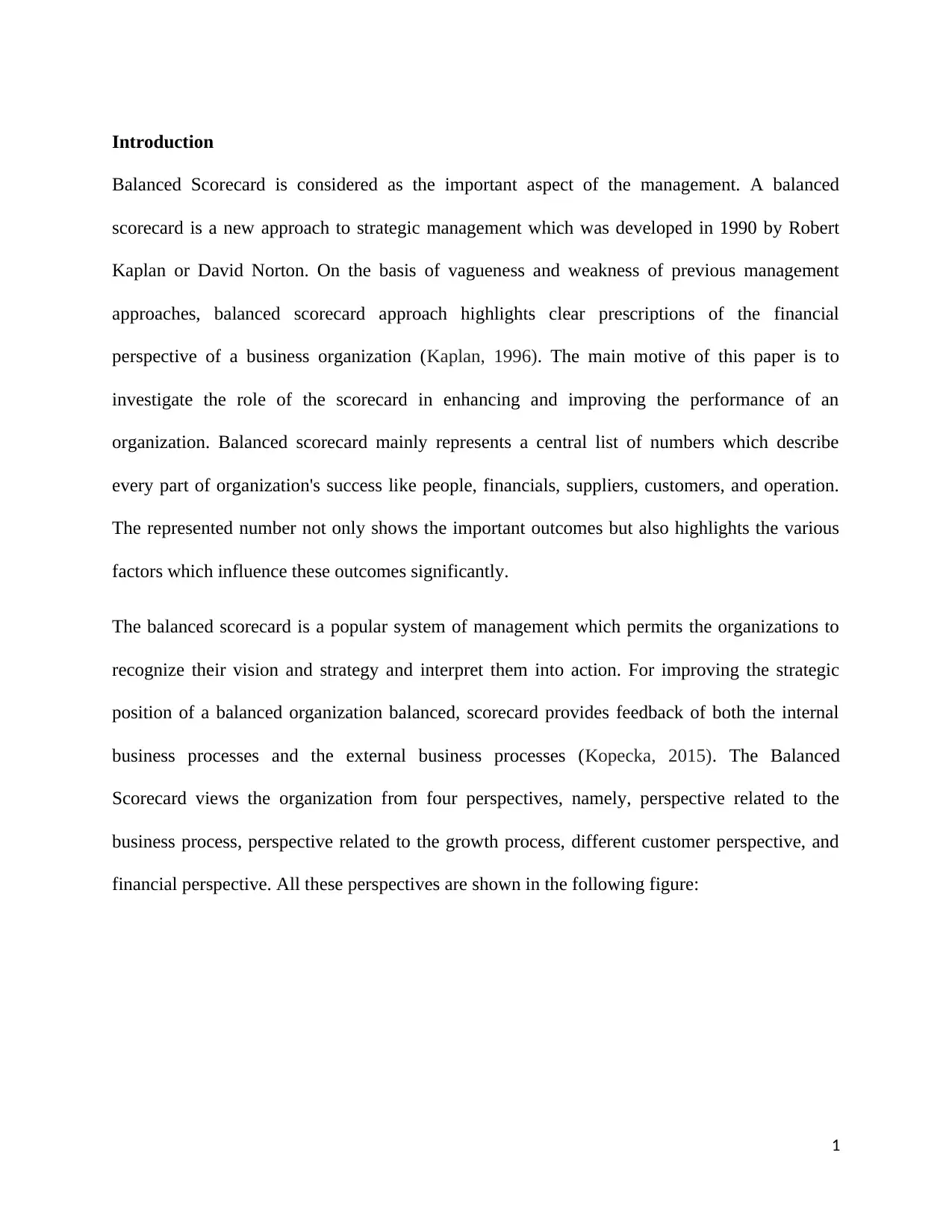
Introduction
Balanced Scorecard is considered as the important aspect of the management. A balanced
scorecard is a new approach to strategic management which was developed in 1990 by Robert
Kaplan or David Norton. On the basis of vagueness and weakness of previous management
approaches, balanced scorecard approach highlights clear prescriptions of the financial
perspective of a business organization (Kaplan, 1996). The main motive of this paper is to
investigate the role of the scorecard in enhancing and improving the performance of an
organization. Balanced scorecard mainly represents a central list of numbers which describe
every part of organization's success like people, financials, suppliers, customers, and operation.
The represented number not only shows the important outcomes but also highlights the various
factors which influence these outcomes significantly.
The balanced scorecard is a popular system of management which permits the organizations to
recognize their vision and strategy and interpret them into action. For improving the strategic
position of a balanced organization balanced, scorecard provides feedback of both the internal
business processes and the external business processes (Kopecka, 2015). The Balanced
Scorecard views the organization from four perspectives, namely, perspective related to the
business process, perspective related to the growth process, different customer perspective, and
financial perspective. All these perspectives are shown in the following figure:
1
Balanced Scorecard is considered as the important aspect of the management. A balanced
scorecard is a new approach to strategic management which was developed in 1990 by Robert
Kaplan or David Norton. On the basis of vagueness and weakness of previous management
approaches, balanced scorecard approach highlights clear prescriptions of the financial
perspective of a business organization (Kaplan, 1996). The main motive of this paper is to
investigate the role of the scorecard in enhancing and improving the performance of an
organization. Balanced scorecard mainly represents a central list of numbers which describe
every part of organization's success like people, financials, suppliers, customers, and operation.
The represented number not only shows the important outcomes but also highlights the various
factors which influence these outcomes significantly.
The balanced scorecard is a popular system of management which permits the organizations to
recognize their vision and strategy and interpret them into action. For improving the strategic
position of a balanced organization balanced, scorecard provides feedback of both the internal
business processes and the external business processes (Kopecka, 2015). The Balanced
Scorecard views the organization from four perspectives, namely, perspective related to the
business process, perspective related to the growth process, different customer perspective, and
financial perspective. All these perspectives are shown in the following figure:
1
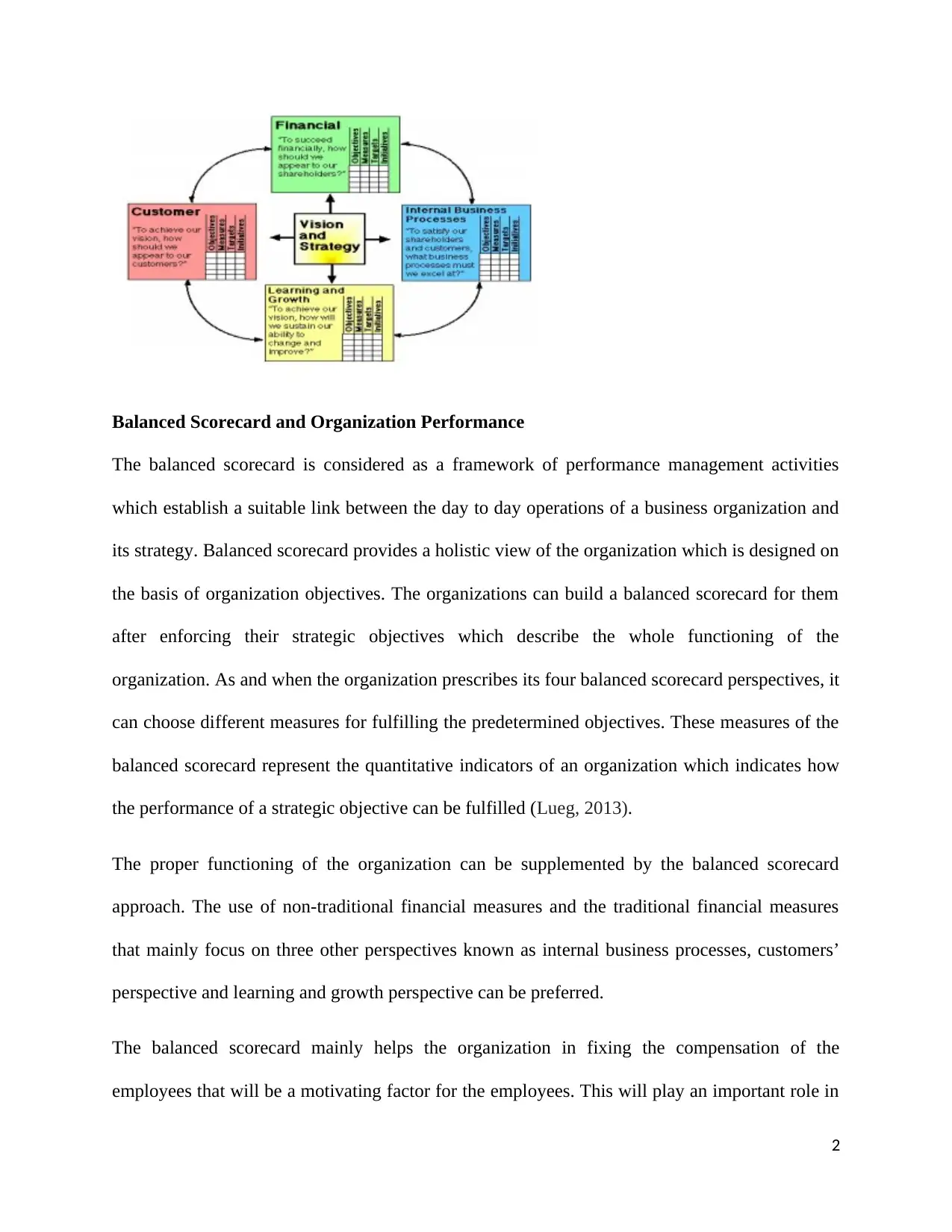
Balanced Scorecard and Organization Performance
The balanced scorecard is considered as a framework of performance management activities
which establish a suitable link between the day to day operations of a business organization and
its strategy. Balanced scorecard provides a holistic view of the organization which is designed on
the basis of organization objectives. The organizations can build a balanced scorecard for them
after enforcing their strategic objectives which describe the whole functioning of the
organization. As and when the organization prescribes its four balanced scorecard perspectives, it
can choose different measures for fulfilling the predetermined objectives. These measures of the
balanced scorecard represent the quantitative indicators of an organization which indicates how
the performance of a strategic objective can be fulfilled (Lueg, 2013).
The proper functioning of the organization can be supplemented by the balanced scorecard
approach. The use of non-traditional financial measures and the traditional financial measures
that mainly focus on three other perspectives known as internal business processes, customers’
perspective and learning and growth perspective can be preferred.
The balanced scorecard mainly helps the organization in fixing the compensation of the
employees that will be a motivating factor for the employees. This will play an important role in
2
The balanced scorecard is considered as a framework of performance management activities
which establish a suitable link between the day to day operations of a business organization and
its strategy. Balanced scorecard provides a holistic view of the organization which is designed on
the basis of organization objectives. The organizations can build a balanced scorecard for them
after enforcing their strategic objectives which describe the whole functioning of the
organization. As and when the organization prescribes its four balanced scorecard perspectives, it
can choose different measures for fulfilling the predetermined objectives. These measures of the
balanced scorecard represent the quantitative indicators of an organization which indicates how
the performance of a strategic objective can be fulfilled (Lueg, 2013).
The proper functioning of the organization can be supplemented by the balanced scorecard
approach. The use of non-traditional financial measures and the traditional financial measures
that mainly focus on three other perspectives known as internal business processes, customers’
perspective and learning and growth perspective can be preferred.
The balanced scorecard mainly helps the organization in fixing the compensation of the
employees that will be a motivating factor for the employees. This will play an important role in
2
⊘ This is a preview!⊘
Do you want full access?
Subscribe today to unlock all pages.

Trusted by 1+ million students worldwide
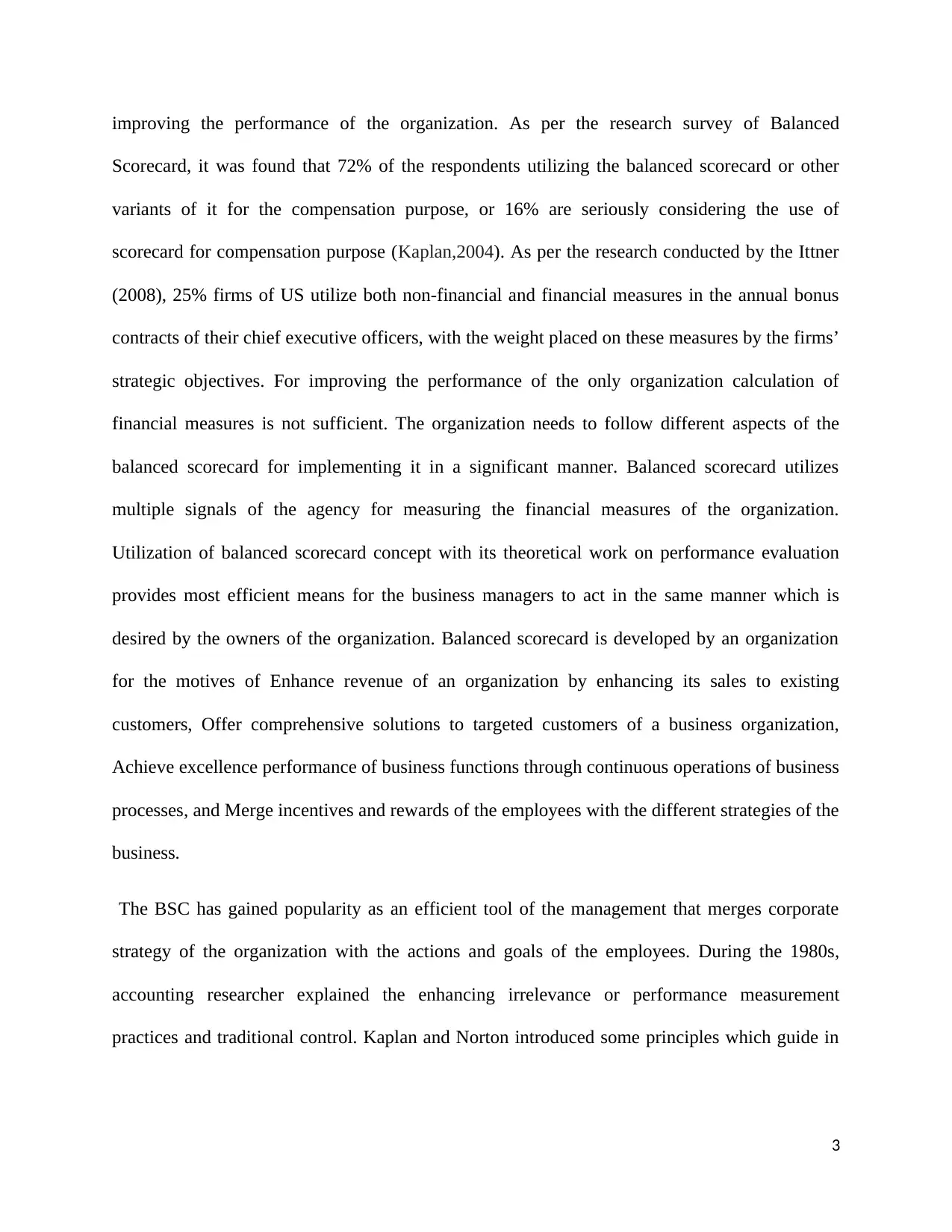
improving the performance of the organization. As per the research survey of Balanced
Scorecard, it was found that 72% of the respondents utilizing the balanced scorecard or other
variants of it for the compensation purpose, or 16% are seriously considering the use of
scorecard for compensation purpose (Kaplan,2004). As per the research conducted by the Ittner
(2008), 25% firms of US utilize both non-financial and financial measures in the annual bonus
contracts of their chief executive officers, with the weight placed on these measures by the firms’
strategic objectives. For improving the performance of the only organization calculation of
financial measures is not sufficient. The organization needs to follow different aspects of the
balanced scorecard for implementing it in a significant manner. Balanced scorecard utilizes
multiple signals of the agency for measuring the financial measures of the organization.
Utilization of balanced scorecard concept with its theoretical work on performance evaluation
provides most efficient means for the business managers to act in the same manner which is
desired by the owners of the organization. Balanced scorecard is developed by an organization
for the motives of Enhance revenue of an organization by enhancing its sales to existing
customers, Offer comprehensive solutions to targeted customers of a business organization,
Achieve excellence performance of business functions through continuous operations of business
processes, and Merge incentives and rewards of the employees with the different strategies of the
business.
The BSC has gained popularity as an efficient tool of the management that merges corporate
strategy of the organization with the actions and goals of the employees. During the 1980s,
accounting researcher explained the enhancing irrelevance or performance measurement
practices and traditional control. Kaplan and Norton introduced some principles which guide in
3
Scorecard, it was found that 72% of the respondents utilizing the balanced scorecard or other
variants of it for the compensation purpose, or 16% are seriously considering the use of
scorecard for compensation purpose (Kaplan,2004). As per the research conducted by the Ittner
(2008), 25% firms of US utilize both non-financial and financial measures in the annual bonus
contracts of their chief executive officers, with the weight placed on these measures by the firms’
strategic objectives. For improving the performance of the only organization calculation of
financial measures is not sufficient. The organization needs to follow different aspects of the
balanced scorecard for implementing it in a significant manner. Balanced scorecard utilizes
multiple signals of the agency for measuring the financial measures of the organization.
Utilization of balanced scorecard concept with its theoretical work on performance evaluation
provides most efficient means for the business managers to act in the same manner which is
desired by the owners of the organization. Balanced scorecard is developed by an organization
for the motives of Enhance revenue of an organization by enhancing its sales to existing
customers, Offer comprehensive solutions to targeted customers of a business organization,
Achieve excellence performance of business functions through continuous operations of business
processes, and Merge incentives and rewards of the employees with the different strategies of the
business.
The BSC has gained popularity as an efficient tool of the management that merges corporate
strategy of the organization with the actions and goals of the employees. During the 1980s,
accounting researcher explained the enhancing irrelevance or performance measurement
practices and traditional control. Kaplan and Norton introduced some principles which guide in
3
Paraphrase This Document
Need a fresh take? Get an instant paraphrase of this document with our AI Paraphraser
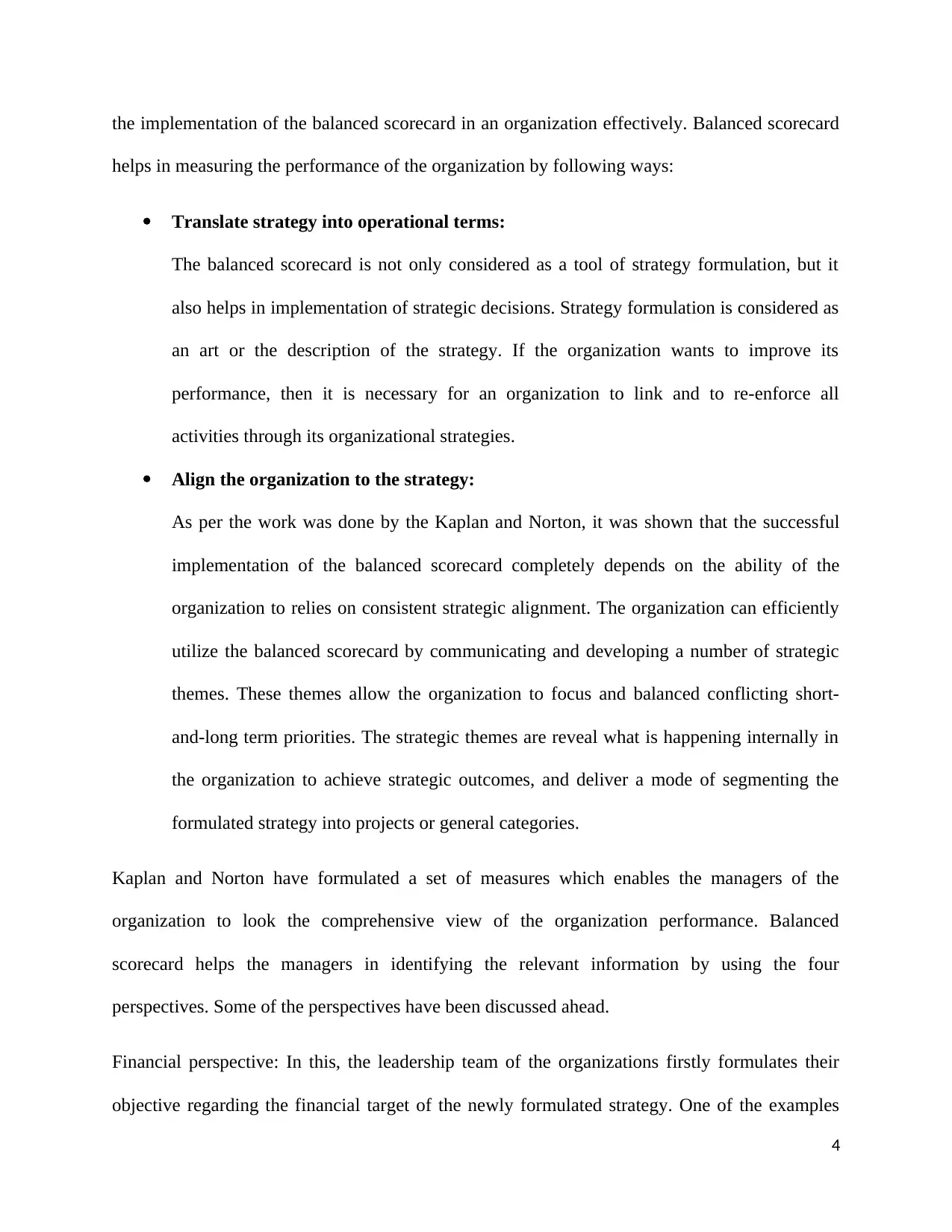
the implementation of the balanced scorecard in an organization effectively. Balanced scorecard
helps in measuring the performance of the organization by following ways:
Translate strategy into operational terms:
The balanced scorecard is not only considered as a tool of strategy formulation, but it
also helps in implementation of strategic decisions. Strategy formulation is considered as
an art or the description of the strategy. If the organization wants to improve its
performance, then it is necessary for an organization to link and to re-enforce all
activities through its organizational strategies.
Align the organization to the strategy:
As per the work was done by the Kaplan and Norton, it was shown that the successful
implementation of the balanced scorecard completely depends on the ability of the
organization to relies on consistent strategic alignment. The organization can efficiently
utilize the balanced scorecard by communicating and developing a number of strategic
themes. These themes allow the organization to focus and balanced conflicting short-
and-long term priorities. The strategic themes are reveal what is happening internally in
the organization to achieve strategic outcomes, and deliver a mode of segmenting the
formulated strategy into projects or general categories.
Kaplan and Norton have formulated a set of measures which enables the managers of the
organization to look the comprehensive view of the organization performance. Balanced
scorecard helps the managers in identifying the relevant information by using the four
perspectives. Some of the perspectives have been discussed ahead.
Financial perspective: In this, the leadership team of the organizations firstly formulates their
objective regarding the financial target of the newly formulated strategy. One of the examples
4
helps in measuring the performance of the organization by following ways:
Translate strategy into operational terms:
The balanced scorecard is not only considered as a tool of strategy formulation, but it
also helps in implementation of strategic decisions. Strategy formulation is considered as
an art or the description of the strategy. If the organization wants to improve its
performance, then it is necessary for an organization to link and to re-enforce all
activities through its organizational strategies.
Align the organization to the strategy:
As per the work was done by the Kaplan and Norton, it was shown that the successful
implementation of the balanced scorecard completely depends on the ability of the
organization to relies on consistent strategic alignment. The organization can efficiently
utilize the balanced scorecard by communicating and developing a number of strategic
themes. These themes allow the organization to focus and balanced conflicting short-
and-long term priorities. The strategic themes are reveal what is happening internally in
the organization to achieve strategic outcomes, and deliver a mode of segmenting the
formulated strategy into projects or general categories.
Kaplan and Norton have formulated a set of measures which enables the managers of the
organization to look the comprehensive view of the organization performance. Balanced
scorecard helps the managers in identifying the relevant information by using the four
perspectives. Some of the perspectives have been discussed ahead.
Financial perspective: In this, the leadership team of the organizations firstly formulates their
objective regarding the financial target of the newly formulated strategy. One of the examples
4
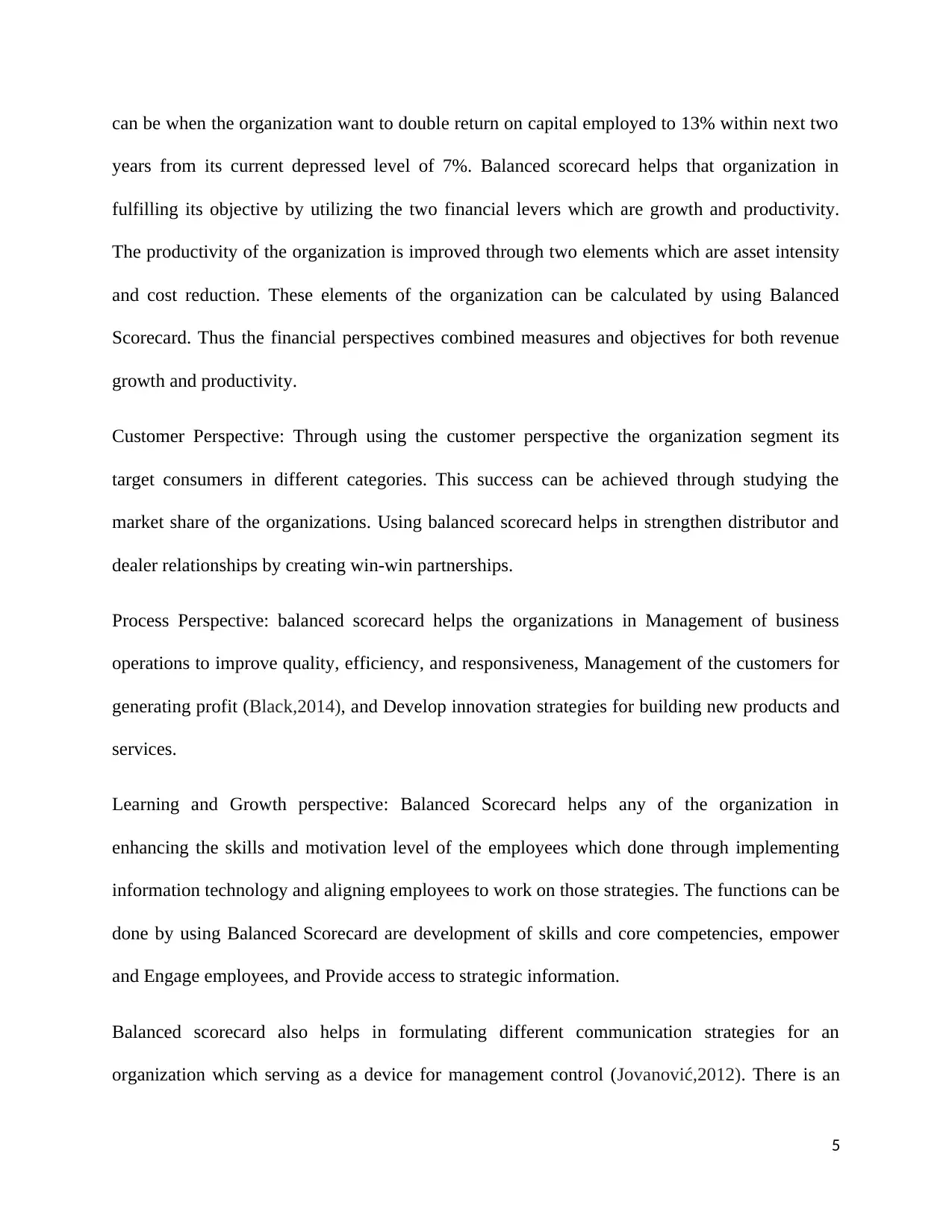
can be when the organization want to double return on capital employed to 13% within next two
years from its current depressed level of 7%. Balanced scorecard helps that organization in
fulfilling its objective by utilizing the two financial levers which are growth and productivity.
The productivity of the organization is improved through two elements which are asset intensity
and cost reduction. These elements of the organization can be calculated by using Balanced
Scorecard. Thus the financial perspectives combined measures and objectives for both revenue
growth and productivity.
Customer Perspective: Through using the customer perspective the organization segment its
target consumers in different categories. This success can be achieved through studying the
market share of the organizations. Using balanced scorecard helps in strengthen distributor and
dealer relationships by creating win-win partnerships.
Process Perspective: balanced scorecard helps the organizations in Management of business
operations to improve quality, efficiency, and responsiveness, Management of the customers for
generating profit (Black,2014), and Develop innovation strategies for building new products and
services.
Learning and Growth perspective: Balanced Scorecard helps any of the organization in
enhancing the skills and motivation level of the employees which done through implementing
information technology and aligning employees to work on those strategies. The functions can be
done by using Balanced Scorecard are development of skills and core competencies, empower
and Engage employees, and Provide access to strategic information.
Balanced scorecard also helps in formulating different communication strategies for an
organization which serving as a device for management control (Jovanović,2012). There is an
5
years from its current depressed level of 7%. Balanced scorecard helps that organization in
fulfilling its objective by utilizing the two financial levers which are growth and productivity.
The productivity of the organization is improved through two elements which are asset intensity
and cost reduction. These elements of the organization can be calculated by using Balanced
Scorecard. Thus the financial perspectives combined measures and objectives for both revenue
growth and productivity.
Customer Perspective: Through using the customer perspective the organization segment its
target consumers in different categories. This success can be achieved through studying the
market share of the organizations. Using balanced scorecard helps in strengthen distributor and
dealer relationships by creating win-win partnerships.
Process Perspective: balanced scorecard helps the organizations in Management of business
operations to improve quality, efficiency, and responsiveness, Management of the customers for
generating profit (Black,2014), and Develop innovation strategies for building new products and
services.
Learning and Growth perspective: Balanced Scorecard helps any of the organization in
enhancing the skills and motivation level of the employees which done through implementing
information technology and aligning employees to work on those strategies. The functions can be
done by using Balanced Scorecard are development of skills and core competencies, empower
and Engage employees, and Provide access to strategic information.
Balanced scorecard also helps in formulating different communication strategies for an
organization which serving as a device for management control (Jovanović,2012). There is an
5
⊘ This is a preview!⊘
Do you want full access?
Subscribe today to unlock all pages.

Trusted by 1+ million students worldwide
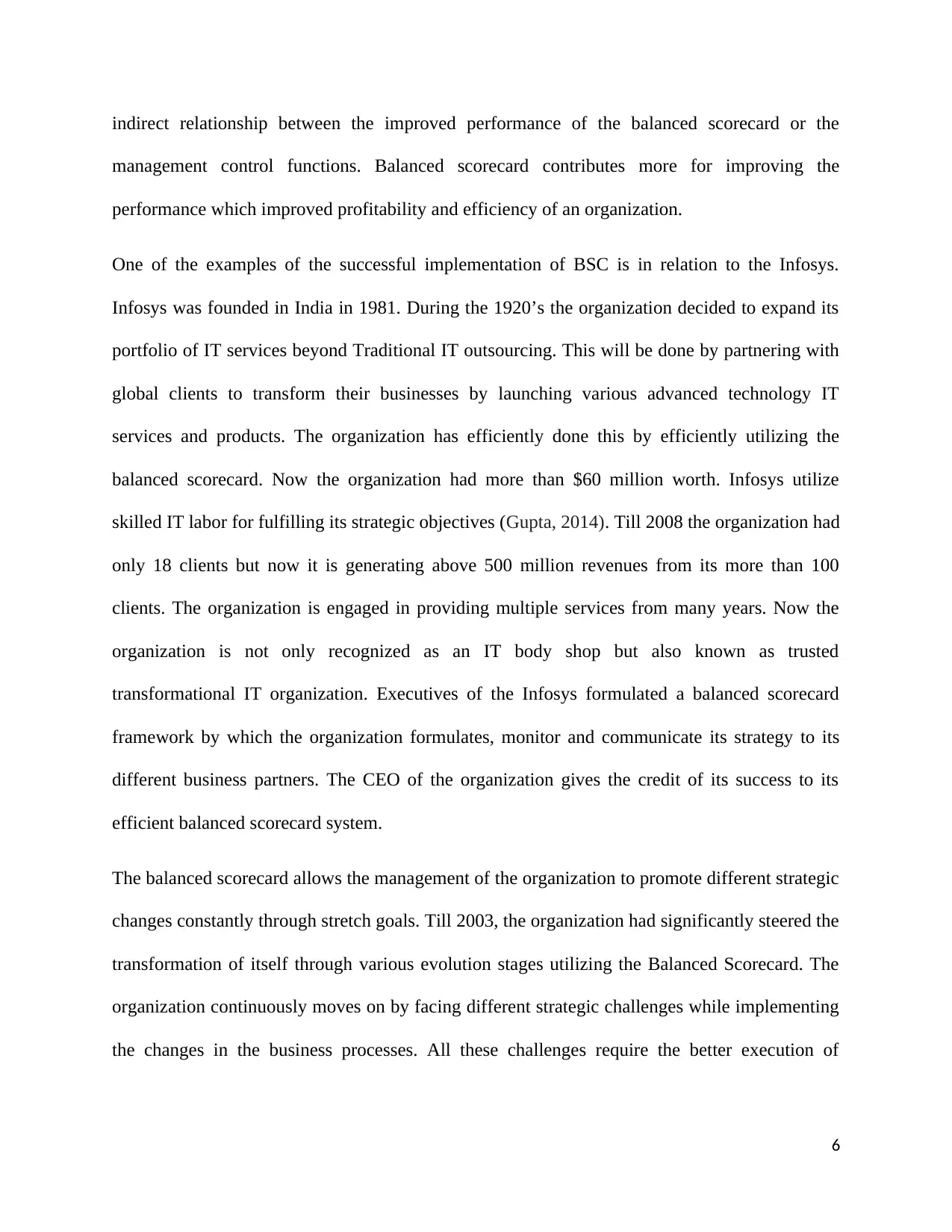
indirect relationship between the improved performance of the balanced scorecard or the
management control functions. Balanced scorecard contributes more for improving the
performance which improved profitability and efficiency of an organization.
One of the examples of the successful implementation of BSC is in relation to the Infosys.
Infosys was founded in India in 1981. During the 1920’s the organization decided to expand its
portfolio of IT services beyond Traditional IT outsourcing. This will be done by partnering with
global clients to transform their businesses by launching various advanced technology IT
services and products. The organization has efficiently done this by efficiently utilizing the
balanced scorecard. Now the organization had more than $60 million worth. Infosys utilize
skilled IT labor for fulfilling its strategic objectives (Gupta, 2014). Till 2008 the organization had
only 18 clients but now it is generating above 500 million revenues from its more than 100
clients. The organization is engaged in providing multiple services from many years. Now the
organization is not only recognized as an IT body shop but also known as trusted
transformational IT organization. Executives of the Infosys formulated a balanced scorecard
framework by which the organization formulates, monitor and communicate its strategy to its
different business partners. The CEO of the organization gives the credit of its success to its
efficient balanced scorecard system.
The balanced scorecard allows the management of the organization to promote different strategic
changes constantly through stretch goals. Till 2003, the organization had significantly steered the
transformation of itself through various evolution stages utilizing the Balanced Scorecard. The
organization continuously moves on by facing different strategic challenges while implementing
the changes in the business processes. All these challenges require the better execution of
6
management control functions. Balanced scorecard contributes more for improving the
performance which improved profitability and efficiency of an organization.
One of the examples of the successful implementation of BSC is in relation to the Infosys.
Infosys was founded in India in 1981. During the 1920’s the organization decided to expand its
portfolio of IT services beyond Traditional IT outsourcing. This will be done by partnering with
global clients to transform their businesses by launching various advanced technology IT
services and products. The organization has efficiently done this by efficiently utilizing the
balanced scorecard. Now the organization had more than $60 million worth. Infosys utilize
skilled IT labor for fulfilling its strategic objectives (Gupta, 2014). Till 2008 the organization had
only 18 clients but now it is generating above 500 million revenues from its more than 100
clients. The organization is engaged in providing multiple services from many years. Now the
organization is not only recognized as an IT body shop but also known as trusted
transformational IT organization. Executives of the Infosys formulated a balanced scorecard
framework by which the organization formulates, monitor and communicate its strategy to its
different business partners. The CEO of the organization gives the credit of its success to its
efficient balanced scorecard system.
The balanced scorecard allows the management of the organization to promote different strategic
changes constantly through stretch goals. Till 2003, the organization had significantly steered the
transformation of itself through various evolution stages utilizing the Balanced Scorecard. The
organization continuously moves on by facing different strategic challenges while implementing
the changes in the business processes. All these challenges require the better execution of
6
Paraphrase This Document
Need a fresh take? Get an instant paraphrase of this document with our AI Paraphraser
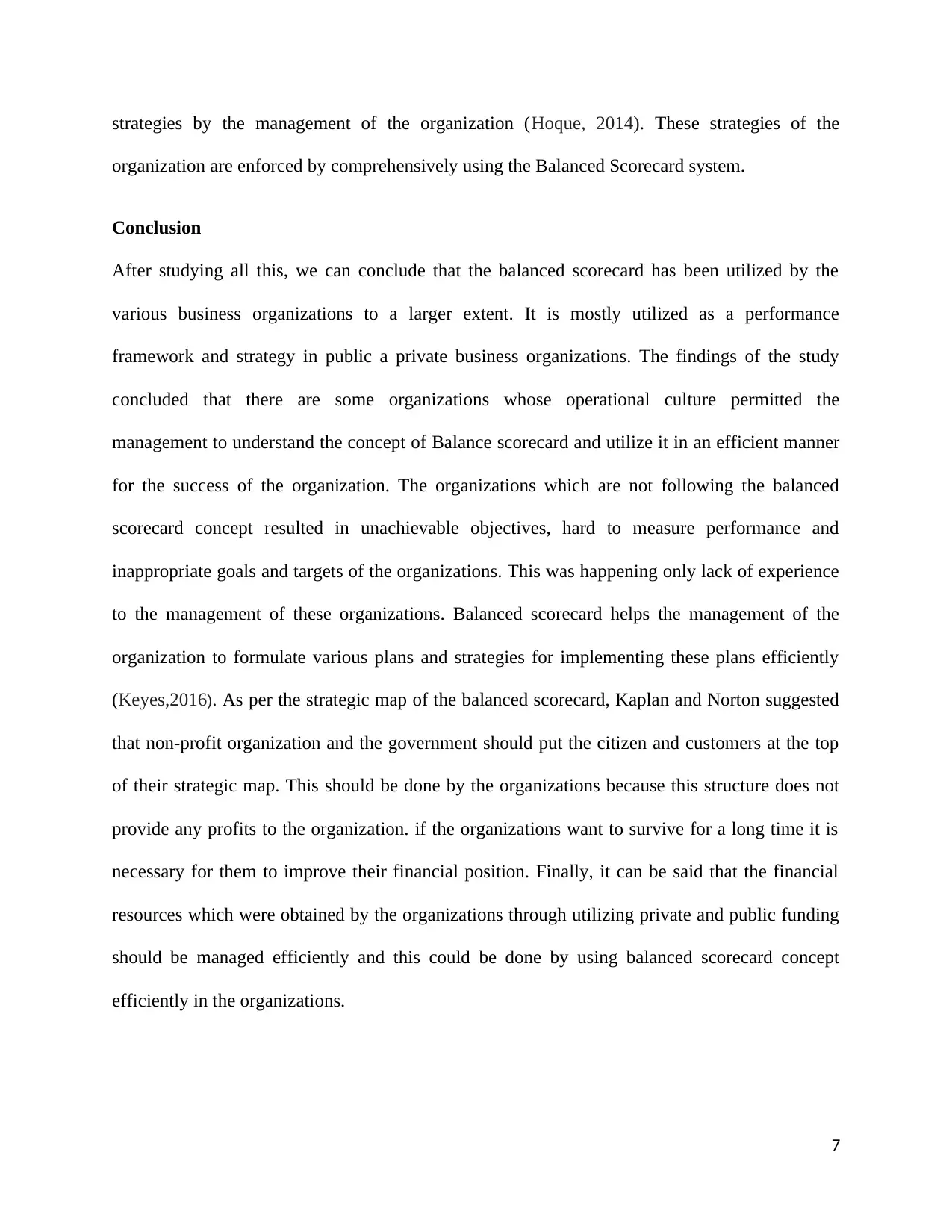
strategies by the management of the organization (Hoque, 2014). These strategies of the
organization are enforced by comprehensively using the Balanced Scorecard system.
Conclusion
After studying all this, we can conclude that the balanced scorecard has been utilized by the
various business organizations to a larger extent. It is mostly utilized as a performance
framework and strategy in public a private business organizations. The findings of the study
concluded that there are some organizations whose operational culture permitted the
management to understand the concept of Balance scorecard and utilize it in an efficient manner
for the success of the organization. The organizations which are not following the balanced
scorecard concept resulted in unachievable objectives, hard to measure performance and
inappropriate goals and targets of the organizations. This was happening only lack of experience
to the management of these organizations. Balanced scorecard helps the management of the
organization to formulate various plans and strategies for implementing these plans efficiently
(Keyes,2016). As per the strategic map of the balanced scorecard, Kaplan and Norton suggested
that non-profit organization and the government should put the citizen and customers at the top
of their strategic map. This should be done by the organizations because this structure does not
provide any profits to the organization. if the organizations want to survive for a long time it is
necessary for them to improve their financial position. Finally, it can be said that the financial
resources which were obtained by the organizations through utilizing private and public funding
should be managed efficiently and this could be done by using balanced scorecard concept
efficiently in the organizations.
7
organization are enforced by comprehensively using the Balanced Scorecard system.
Conclusion
After studying all this, we can conclude that the balanced scorecard has been utilized by the
various business organizations to a larger extent. It is mostly utilized as a performance
framework and strategy in public a private business organizations. The findings of the study
concluded that there are some organizations whose operational culture permitted the
management to understand the concept of Balance scorecard and utilize it in an efficient manner
for the success of the organization. The organizations which are not following the balanced
scorecard concept resulted in unachievable objectives, hard to measure performance and
inappropriate goals and targets of the organizations. This was happening only lack of experience
to the management of these organizations. Balanced scorecard helps the management of the
organization to formulate various plans and strategies for implementing these plans efficiently
(Keyes,2016). As per the strategic map of the balanced scorecard, Kaplan and Norton suggested
that non-profit organization and the government should put the citizen and customers at the top
of their strategic map. This should be done by the organizations because this structure does not
provide any profits to the organization. if the organizations want to survive for a long time it is
necessary for them to improve their financial position. Finally, it can be said that the financial
resources which were obtained by the organizations through utilizing private and public funding
should be managed efficiently and this could be done by using balanced scorecard concept
efficiently in the organizations.
7
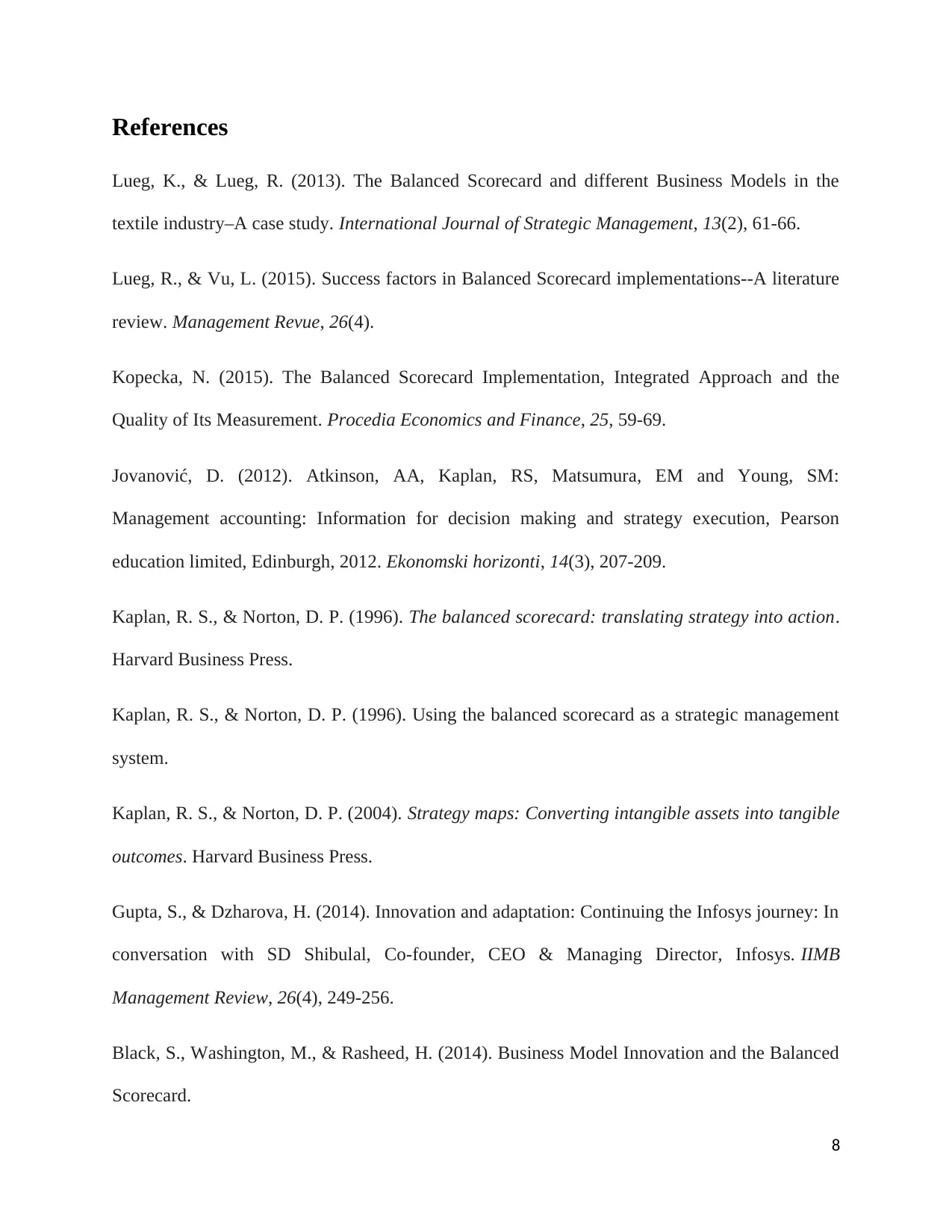
References
Lueg, K., & Lueg, R. (2013). The Balanced Scorecard and different Business Models in the
textile industry–A case study. International Journal of Strategic Management, 13(2), 61-66.
Lueg, R., & Vu, L. (2015). Success factors in Balanced Scorecard implementations--A literature
review. Management Revue, 26(4).
Kopecka, N. (2015). The Balanced Scorecard Implementation, Integrated Approach and the
Quality of Its Measurement. Procedia Economics and Finance, 25, 59-69.
Jovanović, D. (2012). Atkinson, AA, Kaplan, RS, Matsumura, EM and Young, SM:
Management accounting: Information for decision making and strategy execution, Pearson
education limited, Edinburgh, 2012. Ekonomski horizonti, 14(3), 207-209.
Kaplan, R. S., & Norton, D. P. (1996). The balanced scorecard: translating strategy into action.
Harvard Business Press.
Kaplan, R. S., & Norton, D. P. (1996). Using the balanced scorecard as a strategic management
system.
Kaplan, R. S., & Norton, D. P. (2004). Strategy maps: Converting intangible assets into tangible
outcomes. Harvard Business Press.
Gupta, S., & Dzharova, H. (2014). Innovation and adaptation: Continuing the Infosys journey: In
conversation with SD Shibulal, Co-founder, CEO & Managing Director, Infosys. IIMB
Management Review, 26(4), 249-256.
Black, S., Washington, M., & Rasheed, H. (2014). Business Model Innovation and the Balanced
Scorecard.
8
Lueg, K., & Lueg, R. (2013). The Balanced Scorecard and different Business Models in the
textile industry–A case study. International Journal of Strategic Management, 13(2), 61-66.
Lueg, R., & Vu, L. (2015). Success factors in Balanced Scorecard implementations--A literature
review. Management Revue, 26(4).
Kopecka, N. (2015). The Balanced Scorecard Implementation, Integrated Approach and the
Quality of Its Measurement. Procedia Economics and Finance, 25, 59-69.
Jovanović, D. (2012). Atkinson, AA, Kaplan, RS, Matsumura, EM and Young, SM:
Management accounting: Information for decision making and strategy execution, Pearson
education limited, Edinburgh, 2012. Ekonomski horizonti, 14(3), 207-209.
Kaplan, R. S., & Norton, D. P. (1996). The balanced scorecard: translating strategy into action.
Harvard Business Press.
Kaplan, R. S., & Norton, D. P. (1996). Using the balanced scorecard as a strategic management
system.
Kaplan, R. S., & Norton, D. P. (2004). Strategy maps: Converting intangible assets into tangible
outcomes. Harvard Business Press.
Gupta, S., & Dzharova, H. (2014). Innovation and adaptation: Continuing the Infosys journey: In
conversation with SD Shibulal, Co-founder, CEO & Managing Director, Infosys. IIMB
Management Review, 26(4), 249-256.
Black, S., Washington, M., & Rasheed, H. (2014). Business Model Innovation and the Balanced
Scorecard.
8
⊘ This is a preview!⊘
Do you want full access?
Subscribe today to unlock all pages.

Trusted by 1+ million students worldwide

Hoque, Z. (2014). 20 years of studies on the balanced scorecard: Trends, accomplishments, gaps
and opportunities for future research. The British accounting review, 46(1), 33-59.
Keyes, J. (2016). Implementing the IT balanced scorecard: Aligning IT with corporate strategy.
CRC Press.
9
and opportunities for future research. The British accounting review, 46(1), 33-59.
Keyes, J. (2016). Implementing the IT balanced scorecard: Aligning IT with corporate strategy.
CRC Press.
9
1 out of 10
Related Documents
Your All-in-One AI-Powered Toolkit for Academic Success.
+13062052269
info@desklib.com
Available 24*7 on WhatsApp / Email
![[object Object]](/_next/static/media/star-bottom.7253800d.svg)
Unlock your academic potential
Copyright © 2020–2025 A2Z Services. All Rights Reserved. Developed and managed by ZUCOL.





